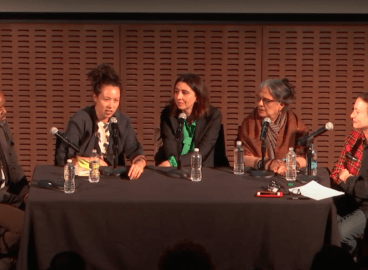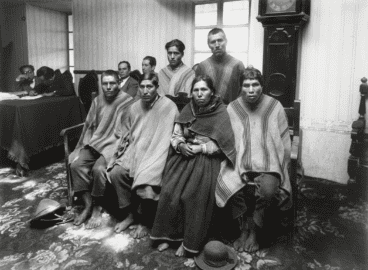How does art history deal with the radical diversity of objects it encompasses? This text proposes that the acknowledgment of radical difference is not just the purview of artworks produced outside Western Europe and North America when reconciled with the so-called “canon.” Rather, incommensurability is intrinsic to art history and, as follows, must be to museum presentation as well. The essay was presented by Luis Pérez-Oramas as part of the annual Contemporary and Modern Art Perspectives (C- MAP) conference in 2017.

It was suggested that I address today a topic that I have recently brought to the attention of my colleagues within C-MAP and at other meetings here at the Museum. This topic has to do with the notion of incommensurability within the radical diversity of objects that we have to deal with in art history—and therefore, and most notably, in our museum practices. By incommensurability, by incommensurable objects, I mean objects for which we might not find a common measure for regulating their significance or meaning, and therefore objects that cannot occupy a fitting location within the conventional geometry of museum representation: objects that have something fundamentally disproportional about them. I believe that the very matter of our discipline—either art history or art criticism or art curatorship—is this array of fundamentally disproportional objects, this variety of material objects and the embodied gestures and ideas that constantly resist being reduced to a common form of proportional representation.
It was also suggested that I address here what seems to be a case study for this problem, which was the exhibition of works by Tarsila do Amaral at MoMA in 2018.
In order to do that, I would like to begin this short talk with this image. A friend who lives in Holland recently sent it to me. We all recognize “Mondrian,” or his “trace,” in the pattern that serves here to ornament an electrical power source, a kind of kiosk, in the urban fabric of the Dutch city of Leyden. I was told that the phrase inscribed on the roof of this small building reads as follows: “Present hides itself behind.” Behind this kiosk? Behind Mondrian? Behind what is left of Mondrian after his legacy became ornament, popular painting, urban device?

We could juxtapose that image to this one. You might have already recognized on the body of this race car the very image of Tarsila do Amaral’s emblematic painting titled Abaporu.
This painting, conceived in 1928, bears a title composed from two Tupi words (Aba/Poru) meaning the man who eats men, the human who digests humans, the cannibal.
We know that Tarsila embodied through her works from the 1920s the Brazilian anthropophagic project of modernity, the idea that by evoking the mythical presence of anthropophagic rituals in pre-Westernized Brazil, modern Brazilians could produce the imagination of a future through the symbolic digestion and cultural metabolizing of the Other. The juxtaposition of Mondrian and Tarsila could well constitute a case study for the topic of “incommensurable” objects: nothing seems to relate one to the other, there is no standard of classification or single common significant criteria that can smooth out the friction that these works produce as soon as we look at them together.
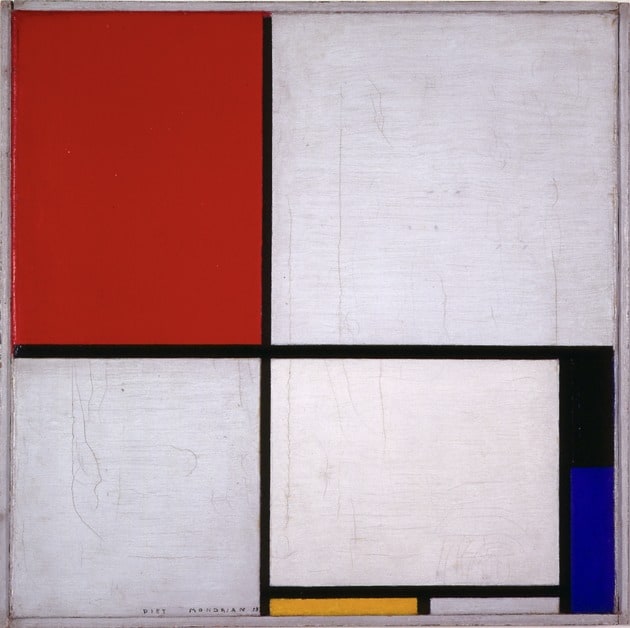

Mondrian embodies a modernity that is totally commensurable with the main narratives of modernism that MoMA has produced since the 1930s. One cannot argue the same about Tarsila, I think. This simply means, for the economy of our museographical narratives, that Mondrian and Tarsila, while being strict contemporaries, are not commensurable unities—in other words: the modernisms that both of them represent cannot be reduced to a common measure, nor can they occupy a proportional place, a proportional dimension, within the same regulated imaginative space of representation—this “Euclidian” image of art history that seems to still regulate our museological hierarchies. They are truly disproportionate, to say the least.
And yet, Abaporu seems to proclaim its belonging to a clear genealogy within the very European modernism within which Mondrian occupies a proportionate commanding place vis-à-vis, for example, Manet. Moreover, Abaporu can be seen as one of the innumerable iterations of the naked bather that Manet conceived in 1863 as Le déjeuner sur l’herbe (Luncheon on the Grass) and that has become a seminal reference for that European modernism in which Mondrian is a paramount hero.
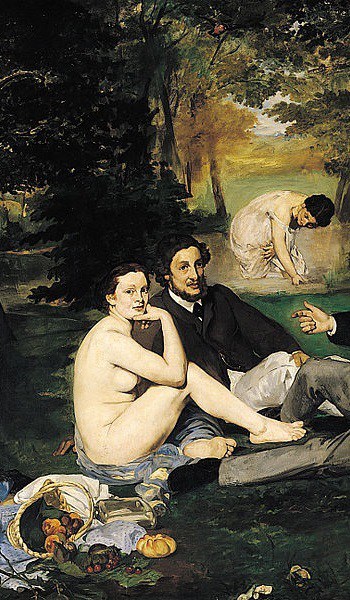
I would, however, argue that Abaporu, as an iteration of Manet, can only be read as a trace, not a quotation, as a mnemonic, relational trace that has emerged as a deformation. Abaporu, the cannibal, has digested Manet’s naked Modern Nymph to the extent that she has become its melancholic, monstrous trace; alone in a desert signified by a monumental phallic cactus, without célibataires surrounding her, she is, ultimately, a sexually undifferentiated figure.
As much as the link between them is improbable, Tarsila and Manet are also antithetically connected: in order to understand Abaporu as a nachleben (a survival) of Manet’s bather, one does acknowledge their antithetical relationship, where difference rather than similitude seems to be the driving force.
Is this just—maybe—an example of “continuous deformation,” as it is called in topology? As such, Abaporu would simply be a case of homeomorphism vis-à-vis Manet’s Nymph.
Well, I do think that our field will enjoy being addressed in topological terms: art history is a field of constant, continuous deformations and, therefore, the museum —insofar as it deals with the plurality of narratives that constitute art history, and therefore with countless cases of disproportionality, countless disproportionate objects—is a place where notions of homotopy, heterotopy, isomorphism, homeomorphism, connectedness, convergence, continuity, and discontinuity are key visible facts that need to be addressed as such, and rethought time and again.
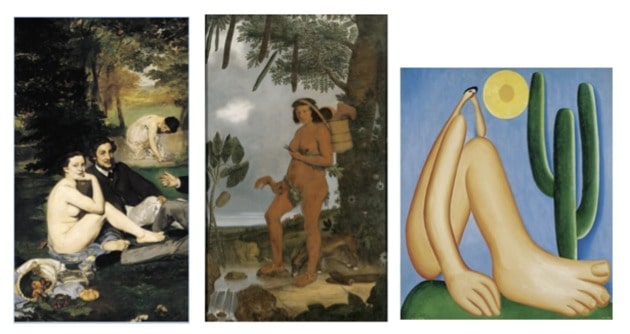
If art history is a system subjected to the action of multiple, undetermined variables, it simply means for us that it cannot be reduced to, neither reflected nor represented by, a single narrative.
Between Manet’s Modern Nymph and Abaporu there is—I would say—a cannibal discontinuity. “Present hides itself behind” means, in this case, that way far before Manet conceived his painting, something happened that belatedly could effect its legacy, or its reception, through a degree of erratic transformation, rather through imposing a rule of continuous deformation.
However, one cannot exclude the possibility of a common ground for Tarsila and Mondrian: although they seem to be incommensurable, they are contemporaries; they are, for large communities in the very same world, similar tokens of modernity.
I want to stress the moral, political dimension of this issue: if modernity matters to human communities, Tarsila and Mondrian might share, in spite of their visible incongruence, some sort of commensurability through the function that their respective legacies embody for large communities living in the same world at the same time.
In the end, the question is does this matter for us here at the Museum?
I have argued that it is helpful, even necessary, to think about these questions: How do we deal with incommensurables in the Museum? How do we manage, in the visualization of our narratives, the many frictions that constitute those very narratives? How do we show Tarsila and Mondrian together?
At any rate, we can’t think that this kind of friction is something specifically related to modernism, or even something new, with no historical precedent, even within the most canonical form of art history.

These two absolutely disproportionate, incongruent, objects were conceived within ten years of each other in the same sixteenth European century, but we have yet to come to terms, it seems, with the common historical ground between them, between the Northern Renaissance and the Italian Renaissance.
But it seems that the Humanist ideal of convenevolezza, or absolute stylistic proportionality between all the elements that constitute a formal unity, still works through our very own imagination of the museum, at least in this museum.
Messy is no popular word here: No Breughel and Michelangelo together in spite of the infinitesimal gap of ten years that separates them, no Tarsila and Mondrian alongside each other, even if both were painted the same day of the same month in 1928.
It is clear that the very same ideology of commensurability constitutes the epistemological ground for an imagination of art history as a space inhabited by objects forming a composition paced through their measured, regulated dimensions: a machine of proportional hierarchies.
I/We have news for you, and it is not recent: Art History—and the Museum—as a Euclidian space is over. Wikipedia: “One of the basic tenets of Euclidean geometry is that two figures (usually considered as subsets) of the plane should be considered equivalent (congruent) if one can be transformed into the other by some sequence of translations, rotations and reflections.”1See https://en.wikipedia.org/wiki/Euclidean_space, accessed in 2017.
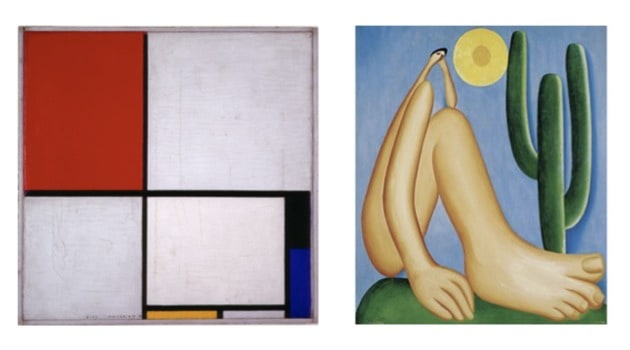
This is precisely what is impossible between Mondrian and Tarsila, or between de Chirico and Mondrian for that matter: none of them can be transformed into the other because there is no sequence of translations, rotations, or reflections; no rule of deformation; no key of proportion that can activate such a transformation.
But we all know that this is not just a formal problem, this is also, and more importantly, a political problem.
My colleagues here at MoMA know that I am literally obsessed with this issue, that I believe that we also need to think of our practice in topological terms: through a reasoning of works of art that excludes the hypothesis (and the facility) of their commensurability.2Cf. Jean-François Lyotard: Duchamp’s TRANS/formers, Leuven: Leuven Univerisity Press, 2010, 66-67. Or, more structurally, as semantic unities—because I claim that works of art are semantic unities that can only activate their agency of significance through their differences, rather than through their similitude.
We don’t have the time to delve here into such a complex set of problems. But as I constantly refer to Jean-François Lyotard’s assertion in Duchamp’s TRANS/formers, which among other references, truly sparked my thinking on these issues, I’d like to read that quote in its entirety here:
“But the discovery of incongruence and incommensurabilities, if one brings it back from the space of the geometrist to that of the citizen, obliges us to reconsider the most unconscious axioms of political thought and practice. If the citizens are not indiscernible, if they are, for instance, both symmetrical in relation to a point (the center, which is the law) and nevertheless non-super imposable on one another (as we know is the case for the owners or bureaucrats of capital and the sellers of labor power, as we know is the case for men and women, for whites and “colored people,” for urbanites and provincials, for young people and adults), then your representation of political space is very embarrassed. And if you haven’t despaired of your life on the pretext that all justice was lost when commensurability was lost, if you haven’t gone running to hide your ignoble distress beneath the authority of a great signifier capable of restoring this geometry, if on the contrary you think, like Yours Truly, that it’s the right moment to render this geometry totally invalid, to hasten its decay and to invent a topological justice, well then, you’ve already understood what a Philistine could be doing searching among the little notes and improvisations of Duchamp: materials, tools, and weapons for politics of incommensurables.”3Cf. Jean-François Lyotard: Duchamp’s TRANS/formers, Leuven: Leuven Univerisity Press, 2010, 68-69.
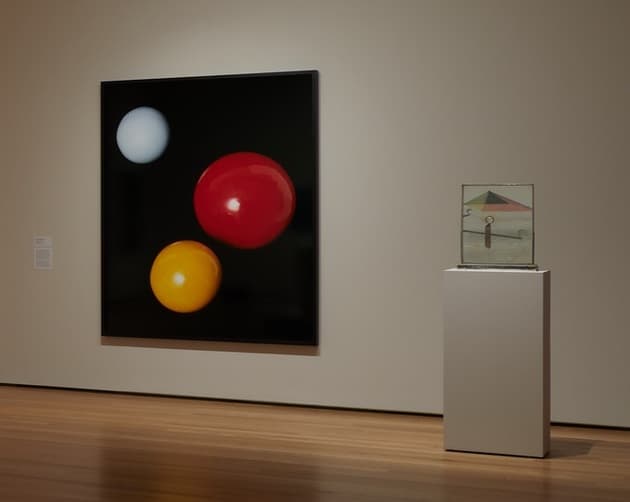
Recently here at MoMA, and for reasons that are not totally unrelated to these arguments, in response to a political urgency, curators acted politically through some unexpected, incongruent, insertions into our most revered art historical galleries.4Editors: Pérez-Oramas is here referring to a series of works by artists from majority-Muslim nations, which were inserted into the permanent collection installation in 2017, in response to the United States government’s restriction of travel to the United States by citizens of those countries. These insertions are examples of a narrative of incommensurables. Regardless of their eventful, political nature, or maybe precisely because of it, these insertions activate a logic of incommensurability in which our most commensurable, stylistically controlled, museographical narratives are displayed: precisely where MoMA looks its best in terms of hygienic, humanistconvenevolezza. Maybe this is a path worth pursuing, among others, if, beyond its political agency and significance we, were to actively think on the complex issues implied by a topological understanding of a world of art where “commensurability is lost” and therefore its “representation is embarrassed,” its constituents being “non-super imposable on one another.”
Every one of these insertions produces a break, a cut—a coupure in the language of Duchamp and, therefore, also in that of Poincaré, the mathematician from whom Duchamp borrowed the term. Every one of these “breaks,” as with Mondrian and Tarsila, has the power of disturbing chronology. And disturbing chronology might be the most effective tool in imagining a different form of art historical topological “justice.”
Reflecting on Duchamp, Lyotard brings this beautiful expression on the function of “breaks”: “an autonomous temporal kernel, as the instance of a potency that gives room to a different temporality.”5Cf. Jean-François Lyotard: Duchamp’s TRANS/formers, Leuven: Leuven Univerisity Press, 2010, 103. He interprets Duchamp’s logic as a “desire to dischronograph time”: Dischronographing duration—I would say through the production of autochronies rather than simultaneities or successions, through relations of dischrony that can spark, each of them, a new “story.”
I do think that you/we have here a program worth trying.
- 1See https://en.wikipedia.org/wiki/Euclidean_space, accessed in 2017.
- 2Cf. Jean-François Lyotard: Duchamp’s TRANS/formers, Leuven: Leuven Univerisity Press, 2010, 66-67.
- 3Cf. Jean-François Lyotard: Duchamp’s TRANS/formers, Leuven: Leuven Univerisity Press, 2010, 68-69.
- 4Editors: Pérez-Oramas is here referring to a series of works by artists from majority-Muslim nations, which were inserted into the permanent collection installation in 2017, in response to the United States government’s restriction of travel to the United States by citizens of those countries.
- 5Cf. Jean-François Lyotard: Duchamp’s TRANS/formers, Leuven: Leuven Univerisity Press, 2010, 103.
